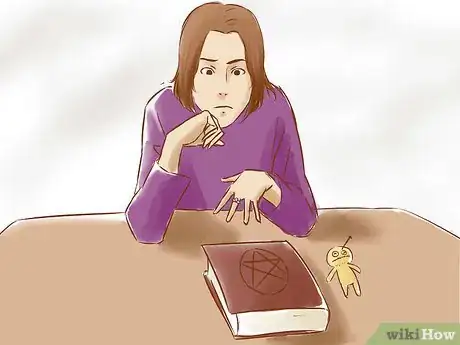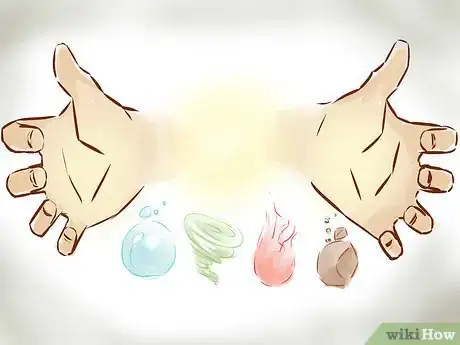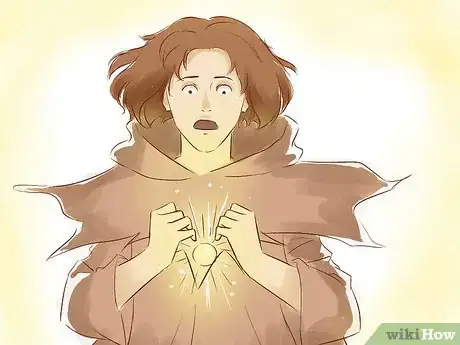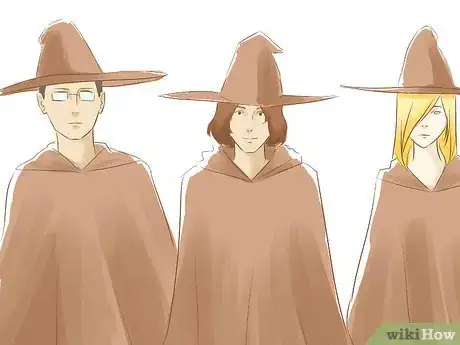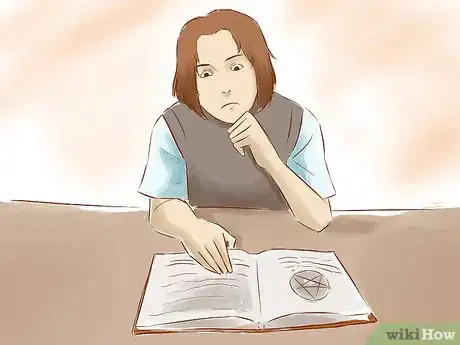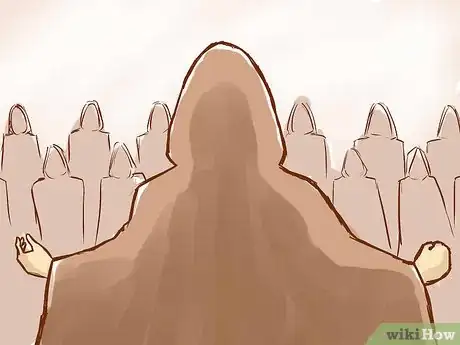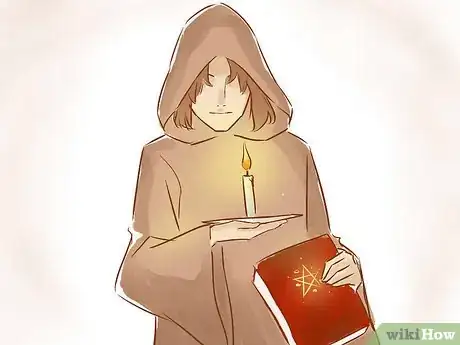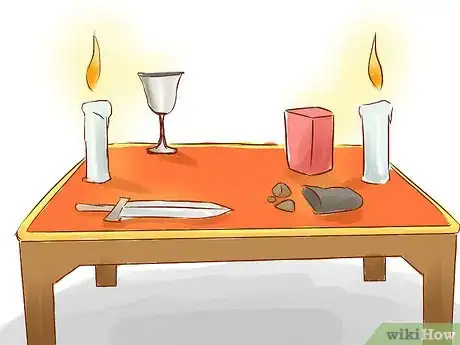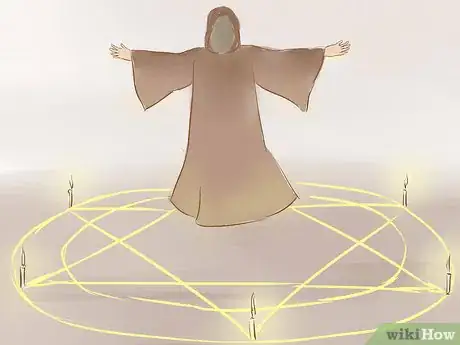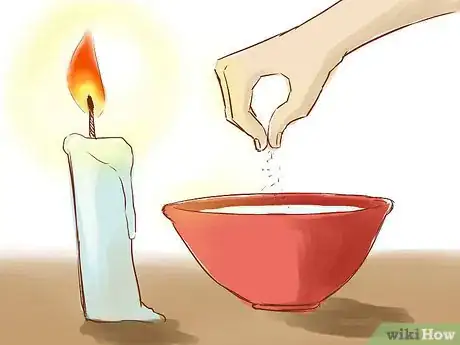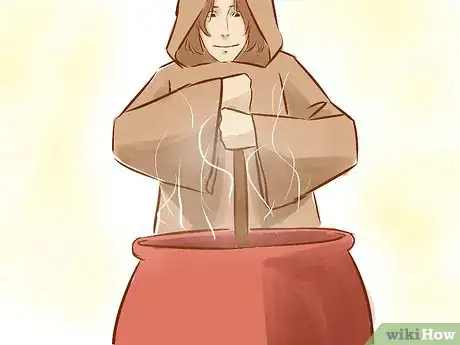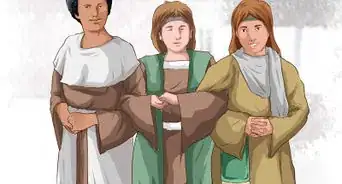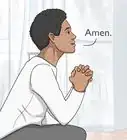wikiHow is a “wiki,” similar to Wikipedia, which means that many of our articles are co-written by multiple authors. To create this article, 55 people, some anonymous, worked to edit and improve it over time.
This article has been viewed 404,690 times.
Learn more...
Witchcraft, in the modern sense of the word, is a catch-all term that describes a variety of neo-pagan practices focused on the self, the earth, and animistic spirits. Though the world of witchcraft may seem daunting at first, there are a number of simple concepts you can learn and basic spells you can practice to start your journey with Wiccanism, as this guide only focuses on the modern Wiccan tradition of witchcraft.
Steps
Ground Work
-
1Understand the scope of this guide. The well-known neopaganist approach to witchcraft (“Wicca”) is hardly the only one. There are several different magical traditions that can all be considered “witchcraft,” which vary substantially between one another in purpose, origin, and worldview. However, because an article that covers all (or even some) of these traditions would become ludicrously complex very quickly, this guide only focuses on the modern Wiccan tradition of witchcraft.
-
2Learn about Wicca. Wicca is a modern religion, based on ideas about early west European paganism, that includes witchcraft as a core component. Wiccan witchcraft is by far the most popular and widely practiced form of witchcraft in the English-speaking world. Wiccans may belong to an organized group, such as a priesthood or coven, or they may operate independently or in loose coalitions.
- Wiccan belief varies from practitioner to practitioner somewhat, but all share belief in some basic concepts: A five-element system (earth, air, fire, water, and spirit) of the world; a clear division between genders and gender roles throughout creation, most clearly embodied by dual deities, a Moon Goddess and a Horned God; and the use of ritual elements that reflect the four suits of a deck of tarot cards, namely the cup or grail, the wand, the knife and/or sword, and the pentacle.
- Witchcraft is only one part of being a Wiccan. Much of the religion is concerned with the acceptance and embrasure of the natural world, its cycles, and the differences between individuals. Seasonal festivals, called Sabbats, and structured religious practice are major components of Wicca. You don't absolutely have to be Wiccan to practice Wiccan witchcraft, but the two are closely tied together.
Advertisement -
3Enter Wicca in a way that suits you. Depending on who you ask, becoming initiated into Wicca is either a matter of personal will, or a matter of ceremonialized induction into a formal group or “coven.” This reflects the young age of the religion, and the considerable range of disagreements about what, exactly, it means to be a “true” Wiccan. However, it also illustrates the extent to which nearly all Wiccans embrace the idea of personal power, responsibility, and freedom of choice. Choose what you believe will work best.
-
4Educate yourself in schools of magical thought. Witchcraft is, essentially, the practice of magic. Because magic is a very personally oriented area of study, there are many competing views of it: how it works, where it comes from, what it means. Like any discipline, a novice in the field of magic should develop a grasp of the different general opinions and approaches to it.
- Wiccans generally believe that the magic of witchcraft is the result of ritually imposing one's will upon the world by strengthening and projecting it through the appropriate mystical channels. This may include invoking the aid of powerful spirits, such as the God and Goddess or the Guardian Spirits of the four elements and directions; it also includes ritual processes to gather or cultivate power within the practitioner him- or herself. Understanding what various concepts and materials embody or represent is all-important to developing the most effective spell possible.
- The related magical tradition of Aleister Crowley posits that magic, though it can put the practitioner in contact with otherworldly forces, is essentially an exercise in self-discipline and mental rigor. Deep concentration, focused meditation, and control of one's thoughts are all key components to generating the personal power required to cast useful spells.
- Many psychologists see magic as a form of self-empowerment that is simply another framework for understanding the power of positive, proactive thought. The effects of magic are felt by the believer because the act of practicing magic primes him or her to see and seize opportunities he or she might otherwise have missed, thus creating a self-fulfilling prophecy of sorts. Those who are able to focus strongly on their goals while maintaining a flexible approach to achieving them are most likely to reap the greatest benefits of magic, according to this model of understanding.
- In many folk traditions of magic, the power of the spell isn't the power of the witch at all, except in its intent. The actual energy that makes the spell effective is coaxed from spirits, elemental forces, or other non-physical entities. The witch's job in this case is to draw in enough outside power for the spell to be effective, being sure to choose the right type of assistance for the job and avoid pulling too much outside force into the human realm.
- Chaos magic is a recently formed and still-popular theory that posits that any system of magic, including others not listed here, can be effective, provided the practitioner believes in its power. According to chaos magic, practicing witchcraft in such a way that you can believe in it is more important than choosing the “right” or “true” path.
Practicing Witchcraft
-
1Study and specialize. Although not scientific in the usual sense of the word, practicing witchcraft nonetheless entails a lifelong dedication to, and passion for, knowledge and understanding. Many practitioners of witchcraft discover that they are more powerful in some areas than others, and become specialists over time, as they continue to learn and practice their craft. There are as many different areas of study available to the practicing witch as there are topics in witchcraft, but here are a few of the broader areas you might find yourself drawn to:
-
Wiccan ritual magic. The one type of magic regularly practiced by most Wiccans is highly ritualized religious magic, with special tools and geometric shapes (especially the pentacle) lending power and meaning to every step.
- Ritual magic is highly flexible; a skilled witch in this area can empower nearly any spell by thoroughly understanding the symbolism of the elements of the ritual and using them to his or her advantage.
- The constant contemplation of the relationship between humanity, nature, and the divine that is required to master ritual magic can also lead to peace of mind, clarity of thought, and exceptional strength of character.
- Wiccan magic is often divided into sets of five types, since the number five is powerful to Wiccans. If you ask ten different Wiccan organizations what those five types are, you're likely to get ten different answers. This guide doesn't even come close to covering all of the possible answers, so ask your coven if you'd like to know the way they view it.
-
Plant, soil, and earth magic. The so-called “green witch” or “cottage witch” not only learns to draw poisons, cures, and other powerful substances from plants, he or she also develops a close understanding of their natural cycles of birth, death, and rebirth. These witches are versed in protective magic as well, drawing from the natural world to ward off ill fortune.
- Studying this type of magic may lead to greater success in reading and understanding one's surroundings, coaxing plants to grow, and other powers that offer practical benefits to the witch's hearth and home.
-
Shamanic magic. Although not strictly connected to the Wiccan tradition, shamanism is widely practiced by witches, and in fact by people of various folk religions all over the world. The basic notion of shamanism is that everything natural which exists in our world has a spirit of its own, a belief which is also called animism. By learning to visit the spirit world or “astral plane,” a shaman can become adept at communicating with these spirits and invoking their aid in the waking world.
- Seasoned shamans may develop a strong sense of spiritual guidance, an ability to “read” people and predict their actions, and powers of divination gained by building relationships with powerful spirit allies.
- In witchcraft terms, shamans are sometimes referred to as “augurs” (prophets and spiritual guides) or “hedge witches” (travelers in the spirit world). Those who seek to communicate with mystical beings that don't have analogous representations in our world, such as fairies or elves, can also be considered shamans of a sort.
-
Other forms of witchcraft. Because witchcraft is often practiced subtly or in secret, there are many witches who don't easily fit into any of the above categories. All of these approaches require the same dedication of mind and spirit that any of the more broadly-defined approaches require. A thirst for knowledge and a need to understand the systems of the world is of the utmost importance to developing any kind of witchcraft. Some of the less commonly seen types of witch include:
- Family witches, witches practicing a hereditary tradition that is kept secret within the family
- “Eclectic” witches, who study extensively and become generalists rather than specialists
- Solitary witches, who develop their own understanding of the craft and pursue knowledge in their own way, without relying on standard practices and rituals.
-
Wiccan ritual magic. The one type of magic regularly practiced by most Wiccans is highly ritualized religious magic, with special tools and geometric shapes (especially the pentacle) lending power and meaning to every step.
-
2Engage in ritual and ceremony. Regardless of your opinion on how and why witchcraft works, or your interest in one field of magic over another, the simple fact remains that humankind bestows power and importance on things we venerate, uplift, and separate from the everyday. This means that the more you treat your witchcraft as something powerful and special, the more of an effect it will have in your life.
- Cultivate the personal within the communal framework. As opposed to most major religious traditions, complete and total submission to an overriding idea or power is not a tenet of Wicca. If you're practicing witchcraft as part of a group of Wiccans, remember that the rituals and spells of witchcraft are as much about personal empowerment as they are about connecting to greater forces. Respect the traditions of your group, but don't shy away from bringing your personal approach to bear on them.
- Find rituals that work for you. If you're a member of a group, their rituals will be lent extra power by the belief of the group. However, if you're practicing witchcraft irregularly or on your own, you'll need to develop a sense of what makes an object, act, or symbol significant to you personally. Use such significant items to create an environment of power and seriousness when you practice witchcraft.
-
3Embrace ethics to maximize practical effects. Magic depends on the will and intent of the practitioner to yield results. The more resolute and certain a witch is of his or her purpose, the more he or she will see and feel the effects of a spell. Therefore, it is important to cultivate a solid ethical and moral foundation through which all actions and interactions can be processed and understood by the practitioner as an individual.
- Begin with self-understanding. This is a lifelong process, but you'll reap the benefits for as long as you continue on the path. Many people seem to go through life without much of a moral code, only following one when it's convenient or easy. You must not be one of those people. Instead, you must be the rare person who does his or her best to always act on principle, even when principles don't seem to matter.
- To develop a strong ethical core, you'll need to truly understand yourself – not just your strengths, but your weaknesses. What things worry or frighten you about yourself? Those are the areas in which you're weak. You don't want to indulge those parts of your personality, but you feel you might not always have the strength to hold them back. By acknowledging and accepting them, you can begin to build stronger defenses against them.
- Continue with self-awareness. As you begin to compensate for your weaknesses and focus on your strengths, you'll begin to see your own morals more clearly. Things that make you uncomfortable are likely things you have a moral opposition to; things that bring you a sense of peace or propriety are probably things in line with your sense of righteousness and decency. Your ethics help control your thoughts and actions, but your morals help you clearly understand the reasons behind them.
- Follow through with self-discipline. The learning process is never a finite one. Like anything solid and strong, your ethics must be constantly maintained. Scan your mind for faults and cracks in your sense of ethics on a regular basis, and either compensate for or reshape them as time goes by. Always try to frame your ethics in terms of an easily-understandable moral code to be sure that you fully grasp not only how you will act in a given situation, but why you will act that way. If you do these things, you will become a principled person, someone for whom few decisions are difficult because the options can be judged internally according to a clearly-defined system that never wavers.
- Begin with self-understanding. This is a lifelong process, but you'll reap the benefits for as long as you continue on the path. Many people seem to go through life without much of a moral code, only following one when it's convenient or easy. You must not be one of those people. Instead, you must be the rare person who does his or her best to always act on principle, even when principles don't seem to matter.
Using Magic
-
1Gather your ritual tools. If you're practicing as a part of a coven or priesthood, they are likely to have elaborate ritual tools and spells for special occasions throughout the year, but every witch who wants to practice magic on his or her own is generally allowed to do so. To cast effective spells, you'll need a number of tools. The specifics vary from witch to witch and coven to coven. The following is a list of some common tools used by most witches, and their meanings or alignments, if any.
- An athame is a dagger (or sometimes a sword), one of the principal tools of witchcraft. It is associated with the male aspect and thus the God, and both the male Quarters, east (air) and south (fire).
- A chalice is a ceremonial cup, and one of the principal tools of witchcraft. It is associated with the female aspect and thus the Goddess. The chalice is connected to the west (water) Quarter, one of the two female Quarters.
- A wand is a length of smooth, straight wood, tapered at one end and sometimes set with a gem or other focusing element. It is a principal tool of witchcraft, and a phallic representation of the God. Like the athame, the wand is associated with the east and south Quarters, and the elements of air and fire.
- The bell is a tool used to send spells to their destination with a pleasing sound. It is associated with the Goddess, and can be rung to invoke her presence during rituals.
- The cauldron is an important practical tool in witchcraft, used to burn items (such as herbs) during spellwork. It is feminine, and associated with the Goddess.
- The censer is a container for burning incense and pouring salt during spells and rituals. It is male, associated with the God, east, and air.
- The besom, or broom, is a common tool in witchcraft. A besom is used to ritually cleanse and purify the space where magic will be performed, and as a ritual element that confers protection. It is associated with both the God and the Goddess, and is connected to the element of water.
-
2Gather other tools. Aside from these powerful implements, there are a number of other tools used in most witchcraft that vary more from spell to spell and witch to witch. Some of the most important of these are described below.
- Candles are an almost universal witch's tool. They're used to absorb and then slowly release your personal energy and the intent of the spell. The color of the candle used for a spell is determined by the purpose of the spell, but there is some disagreement among Wiccans about which colors work best for which spells. Plan to do your own research, and have a rainbow of colored candles (including black and white) on hand.
- Robes are the ritual garments worn during the casting of a spell. They tend to be loose and breathable, and are often color-coded like candles based on the work being done: green for herb magic, brown for work with animals or the self, and so on. Not every tradition of witchcraft requires the use of ritual robes.
- A grimoire is another term for a witch's book of spells. Grimoires can be coven-spanning tomes of powerful group spells, or personal collections written by individual witches. They often include recipes (as for potions and poultices), notes, and ritual instructions as well, as they're intended to be practical reference guides rather than highly stylized implements.
- A Book of Shadows is essentially a witch's journal. It contains a record of which spells have been cast when, and for what purposes; powerful dreams or induced visions; personal reflections and feelings regarding witchcraft; and anything else that seems to be important or seems to stick to you. Some witches also use it for keeping track of spell ideas and original spells they design, though a Grimoire can also be used for that purpose.
-
3Create an altar. An altar or sacred space is the physical representation of the work area for a practicing witch. Altars vary wildly between practitioners, but generally feature some kind of oblong or rectangular raised surface, upon which important tools and spell elements are laid out. Create an altar according to your personal ideas and convictions. An altar is also the space in which the altar elements are set. It is usually set in a permanent location, but temporary altars are sometimes also used.
- When laying implements on the altar, those associated with the Goddess and the feminine should be placed to the left, whereas those associated with the God and the masculine should sit to the right. The front of the altar is often set to face north, though this isn't necessarily required.
-
4Learn to cast and close a circle. The casting of the circle is one of the most basic and important rituals in witchcraft. It defines and protects the altar for the duration of the spell, by inviting the four directional and elemental Quarters to watch over it and protect it. The circle is almost always cast before any other spell is cast.
- Rituals vary in length and ceremony from witch to witch, but at the most basic, casting the circle involves lighting a candle (usually white, for purification) and then ritually invoking the four Quarters in turn, starting with the north or east and working clockwise.
- After a spell or ritual is done, the circle is closed by reversing the casting ceremony: start by facing west and bid each Quarter thanks and farewell in a counterclockwise order, then snuff your candle.
- Ritual language such as a rhymed or metered chant is normally used, and the basic phrasing for each direction is the same, to create repetition.
-
5Cast a simple blessing to attune your body and spirit. This basic spell is performed under the light of the moon, and should be done humbly and with reverence. Begin by casting the circle. Light a white candle for purification, and burn a mixture of sandalwood, balsam, and pine wood in your cauldron. Once the mixture is smoking, fill a simple bowl with pure water, and sprinkle salt over it. Set the bowl before you and wet your finger in it to start the incantation.
- Touch between your eyes first. Say “Bless my eyes, that I may have clarity of vision.” Wet your finger again after this and each part you touch.
- Touch your mouth and say “Bless my mouth, that I may speak the truth.”
- Touch your ears and say “Bless my ears, that I may hear all that is spoken and unspoken.”
- Touch your heart and say “Bless my heart, that I may be filled with love.”
- Touch your bare feet (right, then left is the normal order for rituals) and say “Bless my feet, that I may find and walk my own true path.”
- Extinguish the candle to finish the ritual. When you're finished, be sure to close the circle.
-
6Make a charm bag to empower your dreams. Charm bags are small, enclosed pouches that contain any of a wide array of items. They are used to provide extra energy and focus your will on a specific goal or task. This charm bag empowers your dreams to provide you with clearer and more obvious insight into problems or concerns than regular dreams.
- Choose any fabric you like. If you're using a dyed fabric, blue and white are the colors most associated with mending, purifying, and spirituality.
- Slowly and deliberately sew two pieces of cloth together on three sides, while concentrating on the purpose of the bag (to provide clearer, stronger, and more powerful dreams). The longer you spend doing this, the more your personal power will infuse the bag.
- To extend the time you spend creating the bag even further, consider decorating it with markings, beads, or other attachments when you're done sewing the first three sides.
- Open the loose end of the bag and put just a pinch or two each of the following herbs inside it:
- Peppermint
- Cinnamon
- Lemon verbena
- Vervain (common verbena)
- Marigold flower
- Hops
- Sew the top of the bag closed under the light of a full moon, while charging it and purifying it with your intent. Beginning the next night, rub the bag over the center of your forehead each night before you go to sleep, while concentrating hard on your question or concern. Place the charm bag underneath your pillow and then go to sleep. You should notice its effects within a few nights, at most.
- Be sure to keep a pen and paper at hand to quickly write down details and insights from your dreams before your waking mind forgets them.
-
7Reduce your anxiety with an herbal tea. Herbal tea might not sound like much of a spell, but herbs are powerful magical items. To a witch, only part of an herb's power can be seen or understood by traditional Western medicine; the remainder is awakened by ritual and intent.
- Begin your plant magic by boiling a kettle of clean water.
- Pour a cup of water, and add two teaspoons of valerian root while reciting a short chant to drive away anxiety. End your chant with “As I will, so mote it be” to infuse the concoction with your will.
- In Dorothy Morrison's book Everyday Magic, the incantation is as follows: Nervous anxiety, you are dead / Roots and water, soothe my head / Bring me to your calming peace / As I will, so mote it be. Any similar incantation should work as well.
- Drink the entire cup of tea. Sweeten it with plenty of honey if you don't like the taste. Repeat daily or as needed until your anxiety subsides. Be sure to let the tea cool before you drink it!
Community Q&A
-
QuestionI don't have anyone who's interested in magic to guide me. Can I do this on my own?
 Community AnswerYes, witchcraft is something you're able to do on your own. It will just take more practice.
Community AnswerYes, witchcraft is something you're able to do on your own. It will just take more practice. -
QuestionHow do I cast a love spell?
 Community AnswerCasting a love spell has some consequences. If you cast a love spell on one who doesn't love you, then you have to renew and purify yourself. This can be very long and hard. If the person loves you back, the spell should work. To cast this spell, you must have these ingredients: pink sand (Bermuda Beach has pink sand), cement, conch shell, and a dear object you hold close. Mix the sand, grind up the cement and conch shell, and add water. Drop object into the mixture and chant," Love is yet to come, don't leave your sum. ( person's name) loves me, I plea." chant till you are tired. Wait at least 5 days.
Community AnswerCasting a love spell has some consequences. If you cast a love spell on one who doesn't love you, then you have to renew and purify yourself. This can be very long and hard. If the person loves you back, the spell should work. To cast this spell, you must have these ingredients: pink sand (Bermuda Beach has pink sand), cement, conch shell, and a dear object you hold close. Mix the sand, grind up the cement and conch shell, and add water. Drop object into the mixture and chant," Love is yet to come, don't leave your sum. ( person's name) loves me, I plea." chant till you are tired. Wait at least 5 days. -
QuestionHow do I tell my family that I am interested in practicing witchcraft?
 Community AnswerIf you think they'll be supportive, just tell them. If you don't think they will, you don't have to.
Community AnswerIf you think they'll be supportive, just tell them. If you don't think they will, you don't have to.
Warnings
- Be aware that as a witch, you'll be feared by some and understood by only a few. You may also be ridiculed or scorned. In some cases, you may suffer threats of violence, or even actual violence. Always exercise caution in a new situation to minimize your risk, and contact the local authorities immediately if you feel threatened or harassed.⧼thumbs_response⧽
- Witchcraft helps empower your will and increase its effects on the world around you. If you engage in it out of spite, grief, or frustration, it will only poison your environment and make things worse for you. Always try to frame your spells in a positive way, to encourage positive change and continued improvement in your life instead.⧼thumbs_response⧽
- Witchcraft is a major sin in the world's major religions such as Islam and Christianity. Beware of engaging in such practices if you are a follower of a religion that prohibits witchcraft.⧼thumbs_response⧽
- Everything has karma and a boomerang affect thus the saying "as above, so below" and any type of magick can be good are bad relative to the practitioner... For example money and lust is often deemed "black magick" while protection is deemed "white magick" but ultimately their is no colors instead choices... and spirits... just remember to stay safe within the arcane arts.⧼thumbs_response⧽
About This Article
To try and recreate a spell at home, start by covering a table with ritual items like a dagger and cauldron. When you’re ready to begin, light a white candle, cast a protective circle around your table, and burn a mixture of sandalwood, balsam, and pine wood in your cauldron. Once the cauldron starts to smoke, fill a small bowl with water, sprinkle salt over it, and wet your finger. Then, touch your finger to various parts of your body and whisper incantations to the Goddess.
